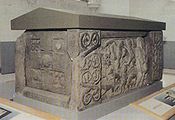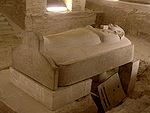Sarcophagus
A sarcophagus is a stone container for a coffin or body. The word comes from Greek "sarx" meaning "flesh," and "phagien" meaning "to eat," so that sarcophagus, which means "eater of flesh." The 5th century B.C.E. Greek historian, Herodotus, noted that early sarcophagi (the plural) were carved from a special kind of rock that consumed the flesh of the corpse inside. In particular, coffins made of a limestone from Assus in the Troad known as lapis Assius had the property of consuming the bodies placed within them, and therefore was also called sarkophagos lithos (flesh-eating stone). All coffins made of limestone have this property to a greater or lesser degree, and the name eventually came to be applied to stone coffins in general.
Sarcophagi were usually made by being carved, decorated or built ornately. Some were built to be freestanding above ground, as a part of an elaborate tomb or tombs. Others were made for burial, or were placed in crypts. In Ancient Egypt, a sarcophagus was usually the external layer of protection for a royal mummy, with several layers of coffins nested within.
The sarcophagus was also used to protect dead bodies.
Eytmology
Description
Origin
Examples
Sarcophagus of the Spouses
The "Sarcophagus of the Spouses" (Italian: Sarcofago degli Sposi) is a late 6th century B.C.E. Etruscan anthropoid sarcophagus. It is 1.14 m high by 1.9 m wide, and is made of painted terracotta. It depicts a married couple reclining at a banquet together in the afterlife (in a scene similar to that from contemporary Greek vases) and was found in 19th century excavations at the necropolis of Cerveteri (ancient Caere). It is now in the National Etruscan Museum of Villa Giulia, Rome.
The smiling faces with their almond shaped eyes and long braided hair, as well as the shape of the feet of the bed, reveal Greek influence. The marked contrast between the high relief busts and the very flattened legs is typically Etruscan. The Etruscan artist's interest focused on the upper half of the figures, especially on the vibrant faces and gesticulating arms. It is very similar to the Sarcophagus from Cerveteri, perhaps by the same artist. Both portray the affection of a man and a woman, an image never before seen in the Greek culture.[citation needed]
St. Andrew
The Saint Andrews Sarcophagus is a Pictish monument dating from the middle of the 8th century. The sarcophagus was recovered beginning in 1833 during excavations by St Andrew's Cathedral, but it was not until 1922 that the surviving components were reunited. The sarcophagus is currently on display at the Cathedral museum in St Andrews, close to the site of its discovery. As originally constructed the sarcophagus would have comprised two side panels, two end panels, four corner pieces and a roof slab. The roof slab is entirely missing, as are most of one side and one end panel and a corner piece so that the extant sarcophagus is essentially L-shaped. The external dimensions of the sarcophagus are 177cm by 90cm and a height of 70cm. The stone used is a local sandstone.
The surviving side panel shows, from right to left, a figure breaking the jaws of a lion, a mounted hunter with his sword raised to strike a leaping lion, and hunter on foot, armed with a spear and assisted by a hunting dog, about to attack a wolf. Although it is not certain that the first two figures represent the same person, 19th century illustrations depict them as if they are. The surviving end panel is much simpler, essentially a cross with four small panels between the arms. The fragments of the missing end panel are similar, but not identical, to the surviving one.
Merenptah
Tomb KV8, located in the Valley of the Kings, was used for the burial of Pharaoh Merenptah of Ancient Egypt's Nineteenth Dynasty.
The burial chamber, located at the end of 160 metres of corridor, originally held a set of four nested sarcophagi. The outer one of these was so voluminous that parts of the corridor had to have their pillars demolished and rebuilt to allow it to be brought in.
Gallery
ReferencesISBN links support NWE through referral fees
- Budge, E. A. Wallis. 2004. The Sarcophagus of Anchnesraneferab Queen of Ahmes II King of Egypt. Kessinger Publishing. ISBN 1417947608
- Grajetzki, Wolfram. 2003. Burial Customs in Ancient Egypt: Life in Death for Rich and Poor. Duckworth Publishers. ISBN 0715632175
Credits
New World Encyclopedia writers and editors rewrote and completed the Wikipedia article in accordance with New World Encyclopedia standards. This article abides by terms of the Creative Commons CC-by-sa 3.0 License (CC-by-sa), which may be used and disseminated with proper attribution. Credit is due under the terms of this license that can reference both the New World Encyclopedia contributors and the selfless volunteer contributors of the Wikimedia Foundation. To cite this article click here for a list of acceptable citing formats.The history of earlier contributions by wikipedians is accessible to researchers here:
The history of this article since it was imported to New World Encyclopedia:
Note: Some restrictions may apply to use of individual images which are separately licensed.





